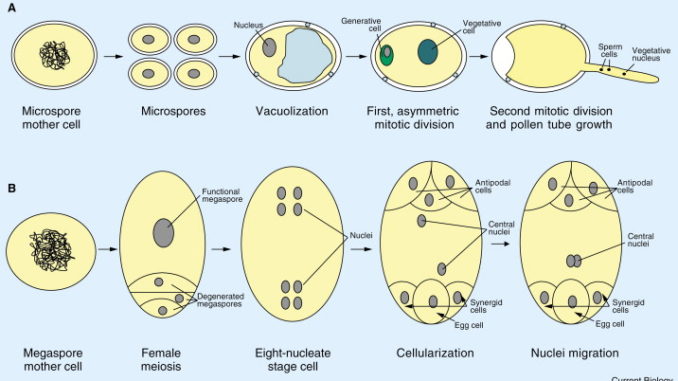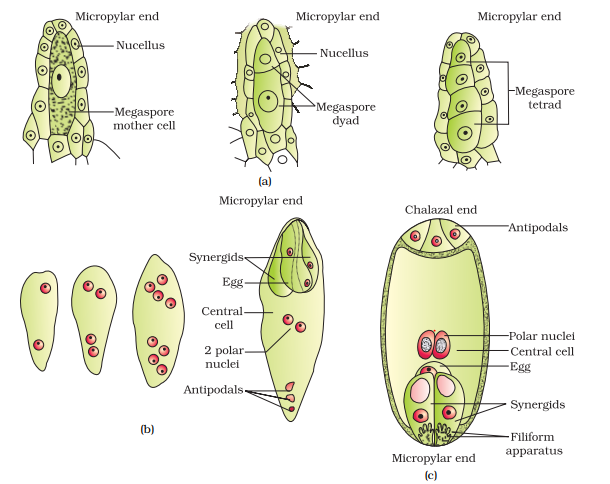
- A gametophyte is the haploid phase in the life cycle of a plant that produces gametes.
- The process of formation of gametes or germ cells from gametophytes in sexually reproducing plants is called gametogenesis.
- Angiosperms reproduce by sexual method most of the times and produce two kinds of gametes;
- Male gametes
- Female gametes
Formation of male gametophyte (Micro-gametogenesis):
- It is the process of formation of a two-celled stage called pollen grain inside an anther.
Structure and development of anther:
- There are homogenous meristematic cells surround by a well-developed epidermis in a young anther. On further development, an anther it becomes slightly four-lobed.
- Some hypodermal cells which are prominently large in size, radially elongated and have more conspicuous nuclei develop into called archesporium cells.
- The archesporial cells divide by periclinal wall to form a primary parietal layer towards the outer side and a primary sporogenous cells towards the inner side.
- The cells of primary parietal layer divide by periclinal and anticlinal walls to form 3-5 layered anther wall. Thus, a mature anther shows 3 different wall layers around each sporangium.
- Epidermis: It is the outermost layer of the sporangium.
- Endothecium: Single layer beneath the epidermis
- Middle layers: 2-3 middle layers are present beneath the endothecium
- Tapetum: It is the innermost single layer of the sporangium wall which provides nourishment to the developing spores.
Development of pollen grains or microspores:
- The primary sporogenous cells usually divide several times and form a large number of microspore mother cells.
- Each microspore mother cell is a diploid structure which divides by meiosis to form four haploid microspores.
- These four haploid microspores remain arranged together for some time and aggregate to form a microspore tetrad.
- Mostly the arrangement of microspores in a tetrad is tetrahedral or isobilateral.
- Mmicrospores, after their separation from the tetrad are called pollen grains.
Structure of a pollen grain:
- Each pollen grain is surrounded by a two-layered wall; the outer thick exine and inner thin and smooth intine.
- Each pollen grain consists of cytoplasm and a nucleus enclosed by a pollen wall.
- A pollen grain contains germ pores, where the exine is thin or absent.
- At the time of pollen germination, the pollen tube emerges through the germ pore.

Image Credit: https://quizizz.com
Development of male gametophyte:
- The male gametophyte in its earlier stage is called a microspore.
- The germination of the pollen grains starts within the pollen sac or microsporangium.
- After mitotic division of the microspore nucleus, two cells are formed; a large vegetative cell and a small generative cell.
- The vegetative nucleus remains in the center while the generative nucleus is attached to the wall of the pollen grain in the beginning.
- Usually, the dehiscense of the anther occurs at this two-celled stage whereas, in some cases they become three-celled before the dehiscence.
- Further development of microspore takes place at the stigma after pollination.
- After pollination, the pollen grains deposited on the stigma absorb stigmatic fluid and swell up.
- Due to swelling, the outer exine ruptures along the germ pore and intine comes out in the form of a pollen tube. Usually, only one tube develops from a pollen grain.
- The pollen tube grows down through the stigma and style and enters the ovarian cavity, normally through the micropyle.
- The tube nucleus lies at the tip of the pollen tube and regulates the growth of the pollen tube.
- The generative cell divides by mitosis and forms two male gametes. Each male gamete consists of a nucleus surrounded by a thin sheath of cytoplasm.
Formation of female gametophyte (Mega-gametogenesis):
- It is the process of formation of female gamete or egg from megaspores within the ovule.
Formation of ovule:
- Ovules develop from the inner wall of the ovary like as a tiny knob.
- The tiny knob gets raised from the ovary wall by a short stalk called funicle.
- The funicle supplies food and water to the ovule.
- The ovule is an ovoid structure and when matured consists of a multilayered nucellar tissue.
- The nucellar is surrounded by one or two integuments, leaving a small gap at the apical end. This gap or opening is called micropyle.
- The micropyle forms the main passage for the entry of pollen tube into the ovule. The basal region of the ovule, where the funicle remains attached is called chalaza.
Development of megaspore:
- In general, a single hypodermal cell of the nucleus differentiates to form the archesporium.
- It becomes more prominent due to its large size, denser cytoplasm and distinct nucleus and is called a primary sprorogenous cell.
- The primary sporogenous cell directly functions as a megaspore mother cell.
- The megaspore mother cell divides meiotically to form a tetrad of four haploid cells.
- The first division is always transverse to form dyad cells. The second division is also transverse to form a linear tetrad of four megaspores.
- Usually only one of the four megaspores is functional and forms the embryo sac or female gametophyte. The other three degenerate.

Development of female gametophyte or embryo sac:
- Megaspore represents the first stage of the female gametophyte and hence develops to form the female gametophyte.
- The female gametophyte is also called an embryo sac.
- The megaspore enlarges and its nucleus divides mitotically to form two nuclei.
- The two nuclei are pushed towards the opposite poles of the cell by a vacuole.
- Both the nuclei divide twice by mitosis to form eight nuclei, four at micropylar end and four at the chalazal end.
- This is followed by the cellular organization of the embryo sac.
- One nucleus from each pole moves towards the center of the embryo sac and fuses to form a polar nucleus or secondary nucleus.
- The remaining three nuclei at the micropylar end organize into egg apparatus. This egg apparatus consists of two lateral synergids and a median large egg cell or ovum or female gamete.
- Similarly, three nuclei from the chalazal end form the antipodal cells. In many plants, the antipodals are persistent and show a possible role in the nutrition of the embryo sac.
- A mature female gametophyte before fertilization has seven nuclei;
- 3 in egg apparatus
- 3 in antipodal cells
- A diploid polar nucleus
- Antipodal cells and the cells in the egg apparatus haploid in nature.
- The formation and development of female gametophyte is followed by the fertilization of the egg cell and the secondary nucleus by the male gametes.
Formation and development of male and female gametophytes in angiosperms
References:
- Mahato R.B, Prasad N.K, 2002, Textbook of Biology. Ekta books distributors Pvt. ltd, Kathmandu, Nepal
- https://tyrocity.com/topic/megagametogenesis